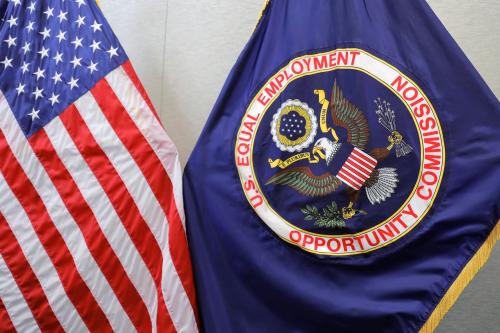Editor’s note: In the lead-up to the CFPB’s rule announcement, the author published a more in-depth framework for thinking about “non-prime” borrowers that need and use small dollar loans. You can read that piece in full here.
On June 2 the Consumer Financial Protection Bureau (CFPB) released a much-anticipated rule aimed at curtailing the predatory nature of some small dollar loans, often called “payday” loans. These loans, which are often the subject of shocking news stories like this one, can trap borrowers in endless debt cycles due to the nature of the loans.
The regulation is a big deal not only because it’s the first time these loans have come under federal regulation. It’s a big win for the millions of Americans that need access to small dollar loans but often face exorbitant interest rates and fees charged by some lenders, which routinely amount to 300-400 percent on an annualized basis.
First things first: Millions of “non-prime” Americans need small dollar loans
In the debate over whether to regulate small dollar loans, or how best to do so, we need to recognize a basic fact: many consumers actually need them.
Millions of Americans still live paycheck to paycheck with little to no safety net to guard against the realities of life. For many—especially for those working multiple jobs or earning hourly wages—income is highly variable, and in the absence of savings, small dollar loans fill a need when money runs out. If you’re a painter, for example, and it rains a few days in a row, it can end up pouring in terms of your ability to make rent, a car payment, or deal with an unforeseen expense.
These borrowers are part of a group of Americans many in the financial industry now call “non-prime” borrowers. Unlike “prime” borrowers, they don’t have access to credit cards with high spending limits and lower interest rates and fees, they don’t have lines of credit at their banks, and they don’t own assets that can be easily liquefied.
In that sense, the unique needs of the non-prime borrower only emphasize the importance of regulating small dollar loans. If people need them regardless of how they work, it’s the responsibility of regulators to ensure access to the credit they provide while limiting harm.
How the new CFPB regulation works—and will it limit access to needed credit?
To start with, the rule rightly uses ability to repay as the key regulatory standard. Like all lending, there will be defaults in small dollar loans. However, the key question in making the loan is whether the consumer will likely be able to repay the loan, under the original conditions of the loan, without the need for subsequent borrowing. Loans that require multiple future loans can become debt traps.
The ability to repay standard is better than the promoted alternative: debt-to-income (DTI). Because they’re common in mortgage lending, many prime borrowers are familiar with DTI standards. DTI, however, requires two assumptions: you know your debt and you know your income. But the reason many borrowers need a payday loan to begin with is because their income is volatile or uncertain. And debt? Because so much of this lending goes un- or under-reported to credit reporting bureaus, it can be hard to know how much debt the borrower has. Further, because the loan is secured by a post-dated check, the lender can stand first in line to get paid back by simply cashing the check on the borrower’s next payday. Thus, the lender is less concerned with what other debts the consumer has.
Will the rule limit access to needed credit? As it’s written, the rule will cut off a large number of loans, but that decrease in number of loans won’t affect as many people you might think. Under the new rule, anyone who wants a small dollar loan will still be able to get one, but the number of loans a person can take out will be limited. Only a quarter of borrowers currently get caught in the cycle of repeated borrowing, taking out seven or more loans. Since these minority of borrowers constitute the majority of loans, it’s likely that the total number of loans will drop significantly, while the actual number of people who take out a loan may or may not decline at all.
The remaining question then is whether the entire market will shrink as a result of the loss of volume of the frequent rollover. This depends on the degree of market innovation. Already before this rule took effect, large segments of the payday market were moving toward longer-term installment loans from six to 36 months, as opposed to the typical two to four week payday loan. If a large loss in the number of loans reduces the volume and economies of scale in this space, we may see fewer payday lenders.
But keep in mind that there are more payday loan stores in America today than there are McDonalds, so a reduction in the number of store fronts starts from a high level. [1] And as more lending moves to online platforms, we may see a reduction in storefronts regardless.
An important first step in protecting the non-prime borrower
The Bureau’s action today will help protect millions of American families who are financially vulnerable and can be subject to abusive lending. One of the key lessons of the financial crisis was that when a lender is able to profit from a loan, regardless of whether the consumer is likely to pay it back, you have a problem. This type of lending needs to be dealt with head-on through strong regulation. Regulators need to think along these lines and be willing to ban outright or functionally curtail these types of predatory products.
But products can be both predatory and fill a need in some segment of society. The question is whether the marketplace can provide responsible, non-predatory products that serve that need.
To effectively regulate products in today’s system, regulators must understand borrowers’ needs and look carefully at the metrics being used. What is the goal of the market and the policy that should regulate that market? I think a laudable goal is to ensure that illiquid borrowers have access to the credit they need in a way that’s beneficial to their circumstances, while insolvent borrowers are not subject to financial abuse, and I think the new CFPB rule is a good step in that direction.
[1] http://www.nbcnews.com/business/economy/there-are-more-payday-lenders-u-s-mcdonalds-n255156
Note: Prior to employment at Brookings, Aaron Klein served as a co-facilitator for a small dollar credit working group hosted by Treliant Risk Advisors.
The Brookings Institution is committed to quality, independence, and impact.
We are supported by a diverse array of funders. In line with our values and policies, each Brookings publication represents the sole views of its author(s).



Commentary
The CFPB’s long-awaited rule on payday loans is a step in the right direction
June 2, 2016